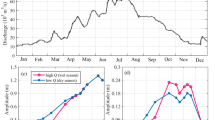Abstract
Tidal propagation in estuaries is affected by friction and fresh water discharge, besides changes in the depth and morphology of the channel. Main distortions imply variations in the mean water level and asymmetry. Tidal asymmetry can be important as a mechanism for sediment accumulation and turbidity maximum formation in estuaries, while mean water level changes can affect navigation depths. Data from several gauges stations from the Amazon estuary and the adjacent coast were analyzed and a 2DH hydrodynamic model was configured in a domain covering the continental shelf up to the last section of the river where the tidal signature is observed. Based on data, theoretical and numerical results, the various influences in the generation of estuarine harmonics are presented, including that of fresh water discharge. It is shown that the main overtide, M4, derived from the most important astronomic component in the Amazon estuary, M2, is responsible for the tidal wave asymmetry. This harmonic has its maximum amplitude at the mouth, where minimum depths are found, and then decreases while tide propagates inside the estuary. Also, the numerical results show that the discharge does not affect water level asymmetry; however, the Amazon river discharge plays an important role in the behavior of the horizontal tide. The main compound tide in Amazon estuary, Msf, generated from the combination of the M2 and S2, can be strong enough to provoke neap low waters lower than spring ones. The results show this component increasing while going upstream in the estuary, reaching a maximum and then slightly decaying.












Similar content being viewed by others
References
Abbot MB, Basco R (1989) Computational fluid mechanics. An introduction for engineering. Longman Group UK Limited, Harlow
AmasSeds (1990) A multidisciplinary Amazon shelf sediment study, EOS. Trans Am Geophys Union 71(45):1771–1777
ANA, National Water Agency, Brazil (2003) http://hidroweb.ana.gov.br/HidroWeb/HidroWeb.asp
Beardsley RC, Candela J, Limeburner R, Geyer WR, Lentz SJ, Castro BM, Cacchione D, Carneiro N (1995) The M2 tide on the Amazon shelf. J Geophys Res 100(C2):2283–2319
Dronkers JJ (1964) Tidal computation in rivers and coastal waters. North-Holland, New York
Dyer KR (1997) Estuaries. A physical introduction. Wiley, London
FEMAR, Fundação de Estudos do Mar, Brazil (2000) Catalogo de estações maregráficas Brasileiras. FEMAR (eds)
Friedrichs CT, Aubrey DG (1994) Tidal propagation in strongly convergent channels. J Geophys Res 99:3321–3336
Gabioux M, Vinzon S, Paiva AM (2005) Tidal propagation over fluid mud layers on Amazon shelf. Contin Shelf Res 25:113–125
Gallo MN (2004) A influência da vazão fluvial sobre a propagação da maré no estuário do rio Amazonas. MSc Thesis, University of Rio de Janeiro, Brazil
Godin G (1985) Modification of river tides by the discharge. J Waterway Port Coastal Ocean Eng 111(2):257–274
Godin G (1999) The propagation of tides up rivers with special considerations on the upper Saint-Lawrence river. Estuarine Coast Shelf Sci 48:307–324
Godin G, Gutierrez G (1996) Non-linear effects in the tide of the Bay of Fundy. Contin Shelf Res 5(3):379–402
Godin G, Martinez A (1994) Numerical experiments to investigate the effects of quadratic friction on the propagation of tides in a channel. Contin Shelf Res 14(7/8):723–748
Ippen AP, Harleman DRF (1966) Tidal dynamics in estuaries. In: Ippen AP (ed) Estuary and coastline hydrodynamics, Mc Graw Hill Book, Chap 10. pp 493–545
Lanzoni S, Seminara G (1998) On tide propagation in convergent estuaries. J Geophys Res 103(C13):30793–30812
Pawlowicz R, Beardsley B, Lentz S (2002) Classical tidal harmonic analysis including error estimates in MATLAB using T_TIDE. Comp Geosci 28:929–937
Pugh DT (1987) Tides, surges and mean sea level. Wiley, London
Rosman PCC (1987) Modeling shallow water bodies via filtering techniques. PhD Thesis. Department of Civil Engineering, Massachusetts Institute of Technology, USA
Rosman PCC (2001) Um sistema computacional de hidrodinâmica ambiental. In: Vieira da Silva RC (ed) Métodos numéricos em recursos hídricos, 5. Associação Brasileira de Recursos Hídricos, Brazil, pp 1–161
Shetye SR, Gouveia AD (1992) On the role of geometry of cross-section in generating flood dominance in shallow estuaries. Estuarine Coast Shelf Sci 35:113–126
Speer PE, Aubrey DG (1985) A study of non-linear tidal propagation in shallow inlet/estuarine systems, II: Theory. Estuarine Coast Shelf Sci 21:207–224
Acknowledgements
The authors express their gratitude to the DHN (Brazilian Navy/Directorate of Hydrography and Navigation) and the HiBAm Project (Hydrology and Geochemistry of the Amazon Basin) for the tide data analyzed in this work and to Adriana Dantas Medeiros and Mariela Gabioux for their help with the model implementation. The first author was supported by a scholarship from CAPES Foundation (Ministry of Education).
Author information
Authors and Affiliations
Corresponding author
Additional information
Responsible Editor: Alejandro Souza
Rights and permissions
About this article
Cite this article
Gallo, M.N., Vinzon, S.B. Generation of overtides and compound tides in Amazon estuary. Ocean Dynamics 55, 441–448 (2005). https://doi.org/10.1007/s10236-005-0003-8
Received:
Accepted:
Published:
Issue Date:
DOI: https://doi.org/10.1007/s10236-005-0003-8



